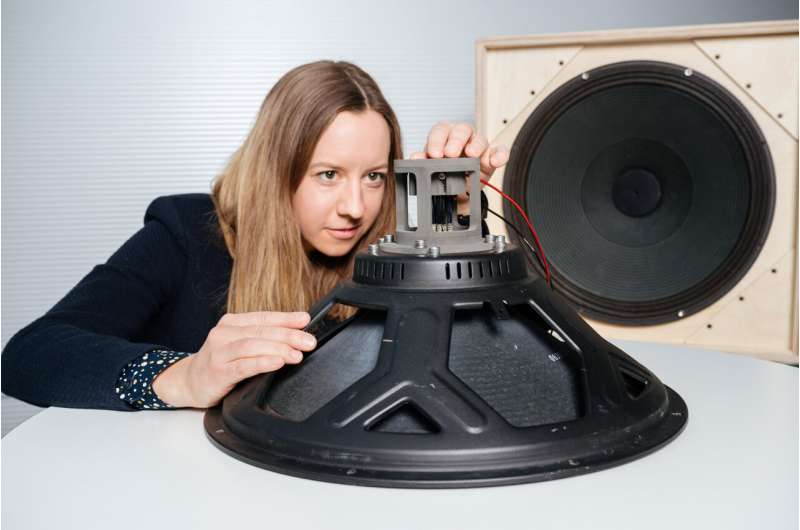Smart films help to make loudspeakers lighter and more energy-efficient

Professors Stefan Seelecke and Paul Motzki at Saarland University are developing intelligent materials that are opening up new avenues in sound reproduction technology: lightweight loudspeakers that use far less energy than their conventional counterparts, novel shapes for sound and signal generators and applications involving noise canceling textiles. The basis for these smart materials are ultrathin silicone films that can act as artificial muscles with their own built-in sensors. The research team will be showcasing their new technology at this year’s Hannover Messe from 17 to 21 April (Hall 2, Stand B34).
Ultrathin films may well replace the heavy and power-thirsty components found in today’s loudspeakers—making speaker systems lighter and environmentally more sustainable. And that wouldn’t just make life easier for the stage technicians and roadies who have to stack speaker towers in stadiums and concert halls, it could also reduce electricity demand in millions of homes. The magnetic speaker drivers that are typically found in public-address systems and stage speaker setups use a lot of electric power. It’s not unusual for power levels to reach hundreds of thousands of watts at large-scale events. But power consumption in domestic surround-sound installations (home music or home cinema systems) is also not inconsiderable. Most of us know how quickly a battery-powered (wireless) speaker needs recharging.
But the new technology being developed by Professor Stefan Seelecke and his research team at the Intelligent Material Systems Lab at Saarland University and at ZeMA (Center for Mechatronics and Automation Technology) in Saarbrücken is markedly more energy-efficient. Their technology does not rely on expensive and difficult-to-source materials; all it needs is a silicone film, some carbon black and a smart control unit. These new film-based drive systems offer the possibility of creating loudspeakers with totally new shapes. “Our smart material systems made from dielectric elastomers are opening up opportunities to rethink much of what we know in the field of acoustics. These systems could help to make loudspeaker technology more sustainable and to develop it in new directions,” said Professor Stefan Seelecke.
The range of possible applications is very broad. For example, the films could be integrated into wall-mounted textiles to actively cancel ambient noise, or if worn on the body, they could emit acoustic signals. The research team from Saarbrücken are showcasing their technology at this year’s Hannover Messe, where they will be looking for commercial and industrial partners with whom they can research and develop the technology for new applications.
The technology is based on thin silicone films coated with an electrically conducting layer to create dielectric elastomers that only require very low levels of electrical power to work. By varying the applied electric field, the researcher team can make the elastomer vibrate at high frequency or execute continuously variable flexing motions. If the elastomeric film is rolled up, it can be used as a new type of speaker driver, replacing the heavy, energy-consuming electromagnets or permanent magnets that drive loudspeaker membranes while still delivering rich bass frequencies.
“A highly flexible carbon black-based electrode layer is printed onto both sides of the silicone film,” explained Professor Paul Motzki, who carried out research in this field as a post-doctoral researcher in Seelecke’s team. “If we apply a voltage to the elastomer, the electrodes attract each other, compressing the polymer and causing it to expand out sideways, thus increasing its surface area,” said Motzki, who now holds a cross-institutional professorship in smart material systems for innovative production at Saarland University and at ZeMA, where he heads the research area Smart Material Systems.
Because they contract in this way, the polymer films have also been referred to as artificial muscles. And every time they change shape, so too does the electrical capacitance of the film. Each capacitance value corresponds to a specific position of the film. The film essentially becomes its own sensor. By combining the measurement data with intelligent algorithms, the team can program extremely rapid motion sequences and thus precise control the behavior of the elastomer film. By altering the applied electric field, the researchers can make the film pulse or make it oscillate or flex at some required frequency.
The film can also be made to generate individual acoustic tones or even multiple tones if several vibrational frequencies are superimposed on one another—turning the elastomeric film into its own loudspeaker. “Depending on the application, we can use the film as both a drive system and a sound generator at the same time. We can develop technical solutions with novel shapes and designs that are also incredibly compact, just a few millimeters thick,” explained Sophie Nalbach, who worked on smart films as part of her doctoral dissertation work in Professor Seelecke’s group and is now a group leader in the Smart Material Systems research area at ZeMA.
While the films do not displace enough air to match the performance of today’s conventional loudspeakers, they could certainly be incorporated into textiles that would then be able to emit acoustic warning signals.
Professor Seelecke’s team is currently working on a number of different research projects aimed at developing these film-based drive systems for a range of different applications, including ways to interconnect them so that they can communicate and cooperate collectively. To do this the researchers will need to impart new capabilities to surfaces and interfaces, which in turn requires further miniaturization of the technology.
The company Mateligent GmbH was spun off from Professor Seelecke’s department to facilitate the transfer of the results of their applications-driven research to commercial and industrial applications.
Citation:
Smart films help to make loudspeakers lighter and more energy-efficient (2023, April 4)
retrieved 4 April 2023
from https://techxplore.com/news/2023-04-smart-loudspeakers-lighter-energy-efficient.html
This document is subject to copyright. Apart from any fair dealing for the purpose of private study or research, no
part may be reproduced without the written permission. The content is provided for information purposes only.
For all the latest Technology News Click Here
For the latest news and updates, follow us on Google News.
